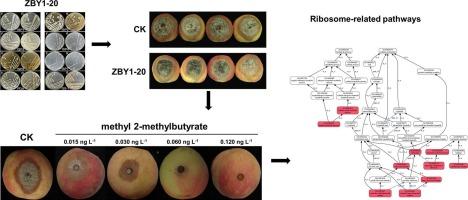Methyl 2-methylbutyrate produced by Streptomyces saccharicans strain ZBY1-20 inhibits Monilinia fructicola causing peach brown rot
IF 3.4
2区 农林科学
Q2 BIOTECHNOLOGY & APPLIED MICROBIOLOGY
引用次数: 0
Abstract
Postharvest peach brown rot disease, predominantly caused by Monilinia fructicola, leads to significant economic losses, with up to 50 % fruit rot. Current control strategies rely heavily on chemical fungicides, raising concerns about pathogen resistance, environmental impact, and pesticide residues. This study explored the potential of volatile metabolites produced by 27 Actinomycetes strains to inhibit M. fructicola. Among them, volatiles from Streptomyces saccharicans strain ZBY1-20 demonstrated limited direct inhibition of brown rot on peaches but effectively suppressed M. fructicola spore germination, suggesting the presence of germination-inhibiting compounds. Comprehensive characterization of ZBY1-20 included BIOLOG phenotypic profiling and physiological assessments. Gas chromatography-mass spectrometry (GC–MS) identified 20 volatile metabolites during a 14-day incubation period, dominated by alcohols, organic acid esters, and terpenes. Methyl 2-methylbutyrate, comprising 5.291 % of the total volatiles, exhibited potent antifungal activity, significantly inhibiting M. fructicola growth and spore production. Notably, 0.1200 ng L-1 of methyl 2-methylbutyrate completely suppressed spore germination and reduced lesion expansion on peach fruit without causing adverse effects. Transcriptomic analysis revealed that methyl 2-methylbutyrate altered M. fructicola gene expression, disrupting ribosome-associated pathways and impairing protein translation. Overall, these findings highlight the efficacy of S. saccharicans strain ZBY1-20 in managing peach brown rot via the production of methyl 2-methylbutyrate, providing an environmentally friendly alternative for postharvest disease control and advancing strategies for fruit preservation.

糖链霉菌ZBY1-20产2-甲基丁酸甲酯抑制桃褐腐病
桃褐腐病主要由桃褐腐菌(Monilinia fructicola)引起,造成重大经济损失,果腐率高达50%。目前的防治策略严重依赖化学杀菌剂,这引起了人们对病原菌耐药性、环境影响和农药残留的担忧。本研究探讨了27株放线菌产生的挥发性代谢物对果分枝杆菌的抑制潜力。其中,糖链霉菌ZBY1-20挥发物对桃褐腐病的直接抑制作用有限,但能有效抑制桃褐腐病孢子的萌发,提示存在抑制萌发的化合物。ZBY1-20的综合鉴定包括BIOLOG表型分析和生理评估。气相色谱-质谱联用(GC-MS)在14天的培养期内鉴定出20种挥发性代谢物,主要是醇、有机酸酯和萜烯。2-甲基丁酸甲酯(占总挥发物的5.291%)具有较强的抗真菌活性,显著抑制果霉的生长和孢子的产生。其中,0.1200 ng L-1的2-甲基丁酸甲酯能完全抑制桃果实孢子萌发,减少病变扩展,且无不良反应。转录组学分析显示,2-甲基丁酸甲酯改变了果糖支原体基因表达,破坏了核糖体相关途径并损害了蛋白质翻译。总之,这些研究结果突出了saccharicans菌株ZBY1-20通过产生2-甲基丁酸甲酯来控制桃褐腐病的功效,为采后病害防治提供了一种环保的替代方法,并为水果保鲜策略的发展提供了新的思路。
本文章由计算机程序翻译,如有差异,请以英文原文为准。
求助全文
约1分钟内获得全文
求助全文
来源期刊

Biological Control
生物-昆虫学
CiteScore
7.40
自引率
7.10%
发文量
220
审稿时长
63 days
期刊介绍:
Biological control is an environmentally sound and effective means of reducing or mitigating pests and pest effects through the use of natural enemies. The aim of Biological Control is to promote this science and technology through publication of original research articles and reviews of research and theory. The journal devotes a section to reports on biotechnologies dealing with the elucidation and use of genes or gene products for the enhancement of biological control agents.
The journal encompasses biological control of viral, microbial, nematode, insect, mite, weed, and vertebrate pests in agriculture, aquatic, forest, natural resource, stored product, and urban environments. Biological control of arthropod pests of human and domestic animals is also included. Ecological, molecular, and biotechnological approaches to the understanding of biological control are welcome.
 求助内容:
求助内容: 应助结果提醒方式:
应助结果提醒方式:


